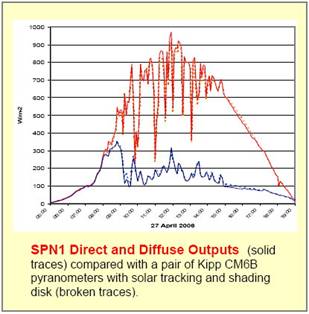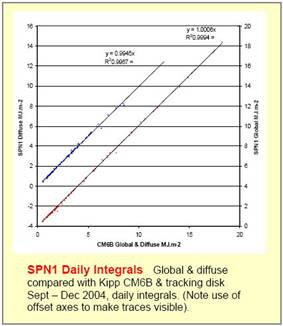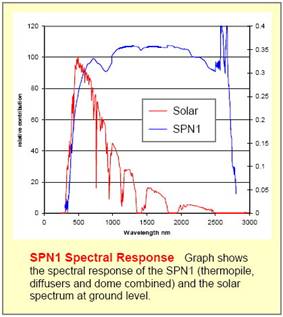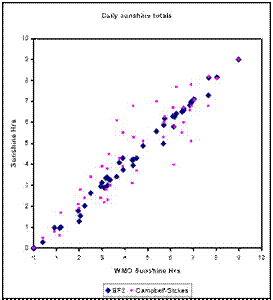The SPN1 uses a row of seven micro-thermal stack sensors and a controller to control the shading to measure the direct and scattered portions of the incoming sunlight. The shading and micro-heat stack sensor emissions allow at least one thermal stack sensor to be completely exposed to sunlight and at least one completely dark, no matter where the sun is. All seven microthermal stack sensors receive the same amount of scattered light. Based on the readings of each thermal stack, the microprocessor calculates the total radiated and scattered ground light and estimates the sunshine condition through these estimates. Output: SPN1 provides two digital outputs for analog voltage output and sunshine hours for total radiation and scattering. These output signals are connected to a data logger such as DL2e and GP1 of Delta-T. It is also possible to connect directly to the computer via the RS232 serial port for readings. Heater: In the case of condensation, icing, and snow, the built-in heater keeps the glass dome transparent, ensuring reliable data in harsh weather conditions. SPN1 design principle: The design principle of SPN1 was tested on Delta-T's BF3 radiation sensor and passed the effective test. The use of miniature thermal stack sensors, high quality glass domes and aluminum housings has greatly improved the original design. Internal electronics are redesigned for high accuracy, low power components. SPN1 subtracts the total radiation to give direct radiation. Experimental comparison results: SPN1 and Kipp & Zonen CM6B One of the Kipp & Zonen CM6B sensors is covered by a sun tracking disc. The test results for the samples are shown below. (SPN1 does not require a sun tracking component) Sunshine hours: The WMO limit of sunshine brightness is 120W. m-2 received on a plane perpendicular to the direct beam of the sun.. It cannot be directly measured using the ground cosine correction sensor, so SPN1 uses a calculation based on direct radiation scatter ratio. The rules, combined with their absolute values, are estimated to be within a few percentages of the WMO standard. This chart is a comparison of the results of the trials conducted over several months for the BF3 and Campbell-stocks sunshine records. According to the WMO standard, the daily error of BF3 is 20 minutes. Correspondingly, Campbell-stocks are even less accurate, with a daily error of nearly one hour. SPN1 is an advanced version of the current BF3 solar sensor that uses the same sunshine hours algorithm.
and are supplied sterile.
airways are single use, latex free and are supplied sterile.
Most endotracheal tubes today are made of polyvinyl chloride, but special tubes made of silicone rubber, latex rubber, or stainless steel are also widely used. Most tubes have an inflatable cuff that seals the trachea and bronchial tree to prevent air leaks and inhalation of stomach contents, blood, secretions and other fluids. Catheters without a capsule may also be used, but their use is mainly limited to pediatric patients (in young children, the cricoid cartilage is the narrowest part of the pediatric airway and usually provides an adequate seal for mechanical ventilation).
Types of endotracheal intubation include oral or nasal, with or without a capsule, prefabricated (e.g., RAE (Ring, Adair, and Elwyn) tubes), reinforced tubes, and double-lumen endobronchial tubes. For human use, tube ID sizes range from 2 to 10.5 mm. Sizes are chosen based on the patient's body size, with smaller sizes used for pediatric and neonatal patients. Tubes larger than 6 mm in diameter usually have inflatable cuff. Originally made of red rubber, most modern tubes are made of polyvinyl chloride. Those placed in the laser field could be flexible metals. Robertshaw (and others) developed a double-lumen endobronchial catheter for thoracic surgery. These allow ventilation from one lung while the other collapses, making surgery easier. After the surgery, the deflated lung is re-inflated to examine the fistula (tears). Another type of endotracheal tube has a small second luminal opening above the inflatable cuff that can be used for aspiration in the nasopharyngeal area and above the cuff to aid in extubation (removal). This allows the aspiration of secretions located above the cuff, which helps reduce the risk of chest infection in patients with prolonged intubation.
Disposable Endotracheal Tube Zhejiang Haisheng Medical Device Co., Ltd , https://www.hisernmedical.com






Design principle of SPN1 radiation sensor
A comprehensive range of laryngeal mask airways suitable for Anesthesia and emergency medicine. All Hisern laryngeal mask airways are single use, latex free
A comprehensive range of laryngeal mask airways suitable for anesthesia and emergency medicine. All Hisern laryngeal mask